When you buy through our links, we may earn a commission. Products or services may be offered by an affiliated entity. Learn more.
Best Mattress for Side Sleepers
Expert Rated in Our Test Lab
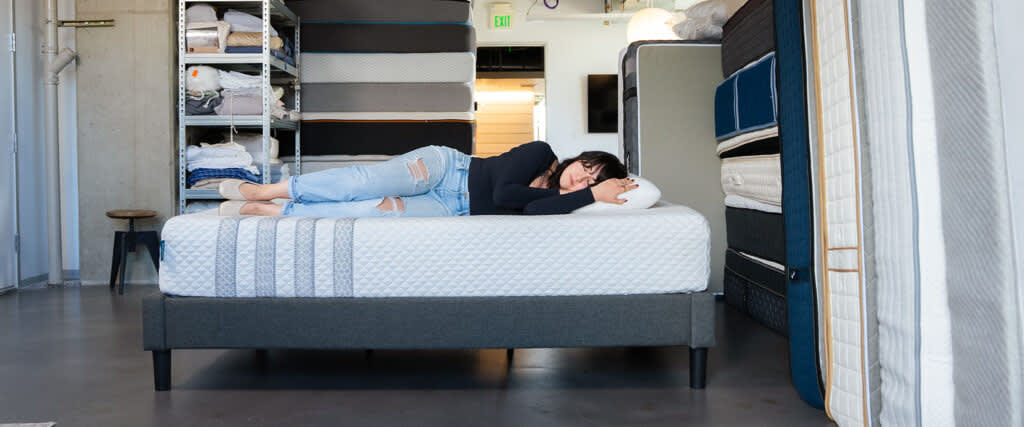
According to multiple studies, adults, on average, sleep on their side 54% of the time. Does that sound like you? Side sleepers appreciate this sleeping position’s capacity to reduce back pain while also improving breathing and digestion. But an uncomfortable or unsupportive mattress, even for side sleepers, can lead to issues like shoulder or hip pain.
Our testing team analyzed hundreds of mattresses to seek out those that provide the best pressure point relief. Each mattress was evaluated across various weight groups, and we considered criteria like temperature regulation, edge support, and motion isolation.
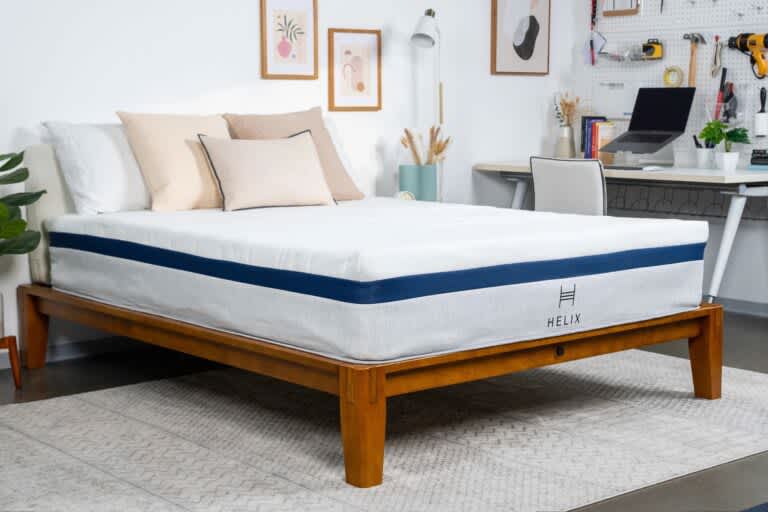

Helix Midnight
We found the Helix Midnight’s thick foam comfort system provides great pressure relief for the hips and shoulders, while robust coils maintain support, making it our top choice for most side sleepers.
The Best Mattresses for Side Sleepers
- Best Overall Mattress – Helix Midnight
- Best Value Mattress – Nectar Mattress
- Most Comfortable Mattress – DreamCloud Mattress
- Best Luxury Mattress – Saatva Classic
- Best Mattress for Back Pain – WinkBed
- Best Mattress for Couples – Leesa Sapira Hybrid
- Best Mattress for Hip Pain – Nolah Evolution 15
- Best Mattress for Shoulder Pain – Brooklyn Bedding Signature Hybrid
- Best Mattress for Pressure Relief – Layla Hybrid
- Best Mattress for Spinal Alignment – Bear Elite Hybrid
- Best Temperature-Regulating Mattress – Birch Mattress
In Depth Reviews
Best Overall Mattress for Side Sleepers
Helix Midnight
20% off + 2 free pillows at Helix
$1,099 at Helix



“As a side sleeper, I really appreciate the Helix Midnight for its adaptive foam comfort layer on top. The surface offers exceptional contouring for my shoulders and hips, and the coils are supportive enough to keep my lower back from sinking.” – Tom Ryan, Head of Product Testing
-
Pros
-
Pocketed coils add bounce and edge support
-
Above-average temperature regulation
-
Memory foam contours and relieves pressure points
-
-
Cons
-
May not provide adequate support for back and stomach sleepers over 230 pounds
-
Foam layers can absorb heat without the upgraded cooling cover
-
Mattress Type
Hybrid
Firmness Options
Medium Firm (6)
Price Range
$749 – $1,399
Trial Period
100 nights (30-night requirement)
Product Details
Many mattresses are constructed with materials that make them comfortable for side sleeping, but the Helix Midnight is one of the only mattresses on the market designed specifically with this position in mind. If you frequently switch between your right and left sides while you sleep due to shoulder pain or stiffness, the Midnight provides the balance of give and support to ensure you’ll be comfortable staying in one position.
How It Performed
Our testers felt the Helix Midnight mattress had a medium firm (6) feel with impressive pressure point relief. The adaptive foams contoured closely to our bodies, cushioning our high-impact areas and preventing aches and pains. The Midnight’s mixed-foam design provides the best combination of relief and support for side sleepers weighing up to 230 pounds.
We found that edge support is another area where the Midnight performed well. The coil base has a reinforced perimeter, which kept us well-supported as we sat on and lied near the edges. This increases the sleepable surface area of the bed and works to prevent sagging along the perimeter over time.
What It’s Made of
The comfort system begins with a layer of adaptive Memory Plus foam, followed by a second layer of high-grade polyfoam that provides ergonomic support. Individually wrapped coils make up the support core, reducing sagging in the midsection and bolstering the edges. A base layer of DuraDense foam works behind the scenes to enhance the overall support and durability. A polyester cover engineered to enhance cooling encases the mattress.
Helix offers 100 nights to try out the Midnight, with a 30-day break-in period. The mattress is covered by a 10-year warranty, and Helix ships free to customers in all 50 states.
Best Value Mattress for Side Sleepers
Nectar Mattress
Up to 40% off mattresses at Nectar
$649 at Nectar



“The Nectar is great at providing the well-loved pressure relief of memory foam, but with an above-average firmness level, so you don’t feel like you’re sinking too far into the mattress. You also can’t beat the year-long sleep trial and lifetime warranty. Our field tester has used the mattress for 3 years and raves about how comfortable the bed still feels, especially for the price-point.” – Lauren Fountain, Senior Editor
-
Pros
-
Excellent motion isolation for couples
-
Relieves back pain and pressure points
-
365-night sleep trial and forever warranty
-
-
Cons
-
All-foam design may sleep too warm for some
-
Limited edge support can lead to sinkage along the perimeter
-
Mattress Type
Foam
Firmness Options
Medium Firm (6)
Price Range
$359 – $1,098
Trial Period
365 nights
Product Details
The Nectar is a high-quality memory foam mattress with an approachable price-point. This makes it suitable for buyers on a budget and high-end shoppers alike.
How It Performed
We found that the Nectar provides a very balanced sleep experience. The thick memory foam comfort layer contoured to our bodies and cradled our sensitive pressure point areas, but the bed’s medium firm (6) feel and sturdy support layers kept us from sinking excessively or feeling too “hugged.” As a result, we believe that the Nectar should feel comfortable for anyone who sleeps on their side and enjoys the cloud-like feel of sleeping “in” — rather than sleeping “on” — their mattress. If you don’t like this “in the bed” feeling, we recommend looking for a bouncier mattress with latex in its comfort system.
Since the Nectar is medium firm, we believe it’s best for people who weigh at least 130 pounds. With contouring foam that doesn’t sink in too deeply, the mattress kept good air circulation around our bodies and did not retain too much heat. The mattress also includes phase change material meant to regulate temperature throughout the night. We found that the Nectar’s combination of foam layers provide top-notch motion isolation and pressure point relief, and the mattress aced all of our motion isolation tests.
What It’s Made of
The Nectar begins with a gel-infused memory foam comfort layer that adapts to the body to relieve pressure. A transitional polyfoam layer adds support under the contouring memory foam, and it helps keep your weight evenly distributed. The polyfoam base layer offers stability and support to the midsection to prevent uncomfortable sagging. A polyester, nylon, and polyethylene cover encases the entire mattress.
Nectar ships free to customers in the contiguous U.S. The company also offers a generous 365-night sleep trial, giving you a full year to try the mattress. The mattress is covered by a lifetime warranty against structural defects.
Most Comfortable Mattress for Side Sleepers
DreamCloud Mattress
Up to 50% off at DreamCloud
$665 at DreamCloud



“We’ve found the DreamCloud’s foam and coil layers offer comfortable support and pressure relief for a wide range of sleeper types. Our field tester credits the mattress for less back pain and fewer restless nights after a year of use.” – Logan Foley, Editorial Director
-
Pros
-
Quilted foam cover creates plush surface
-
Strong balance of contouring and support
-
365-night sleep trial and lifetime warranty
-
-
Cons
-
Thick profile may necessitate deep-pocket sheets
-
Sleepers weighing more than 230 pounds may sink too much
-
Mattress Type
Hybrid
Firmness Options
Medium Firm (6)
Price Range
$499 – $999
Trial Period
365 nights (30-night requirement)
Product Details
The DreamCloud Mattress is a foam hybrid mattress that excelled in multiple performance categories during our testing. We found that the bed’s strong balance of contouring and support makes this mattress a comfortable choice for a wide variety of sleepers.
How It Performed
We rated the DreamCloud at medium firm (6), as it offered adequate cushioning to the shoulders, hips, and other areas where pressure tends to build up during sleep. The polyfoam and coil system provided enough support for sleepers who require some firmness. Though our hot-sleeping testers found that the memory foam may run too warm, the coils should enable enough air circulation to prevent excessive overheating. The mattress also earned higher-than-average marks in motion isolation for a hybrid, so we recommend it if you share the bed with a partner.
What It’s Made of
The mattress begins with a breathable cashmere-blend cover that’s been quilted with soft polyfoam. This produces a plush surface that contoured closely to our bodies. Next is a memory foam layer infused with a cooling gel meant to minimize body heat retention. A transition layer made with polyfoam also provided moderate contouring, but it was firm enough to prevent our bodies from sinking too deeply. The pocketed coil system offers excellent support, with reinforced edges to enhance support around the perimeter.
DreamCloud ships mattresses for free within the contiguous U.S. The company offers a generous 365-night sleep trial, during which you can test and return the mattress after a required 30-day break-in period. A lifetime warranty against structural defects backs mattress purchases.
“I can confidently say that the Saatva Classic is an excellent choice for a supportive bed. The coil-on-coil design makes it stand out in terms of temperature regulation, edge support, and responsiveness.” – Jeremy Klein, Senior Product Expert
-
Pros
-
Multiple firmness and thickness options cater to different sleeper types
-
Responsive and supportive coil-on-coil design
-
Free White Glove delivery for all U.S. orders
-
-
Cons
-
Limited motion isolation due to bouncy surface
-
All returns incur a $99 fee
-
Mattress Type
Innerspring
Firmness Options
Soft (3), Medium Firm (6), Firm (8)
Price Range
$995 – $2,710
Trial Period
365 Nights ($99 Return Fee)
Product Details
Side sleepers generally don’t feel comfortable on innersprings compared to other mattress types. This is because most innersprings contain thin foam layers that offer little to no cushioning for the shoulders, lower back, and hips. We’ve found that the Saatva Classic is unlike these traditional innersprings, as it uses a layer of pocketed minicoils to provide pressure relief. If you’re looking for a high-end model with a thoughtful design, we recommend the Saatva.
How It Performed
The mattress is available in three firmness levels, including a soft (3) option that was popular among our side sleepers weighing less than 130 pounds and a medium firm (6) for those who weigh more. If you sleep on your side and need extra support, you can opt for a firm (8) feel instead. You can also select a profile of 11.5 inches with 4-inch base coils or 14.5 inches with 7-inch base coils. We found that the latter offers more reinforcement and springiness on the surface, making it a better option if you need a bit more support or anyone who appreciates a little extra bounce.
The dual coil layers reinforced the perimeter to keep us from sinking when we slept near the edges or got on and off the mattress. We noted a responsive feel that was easy to move across, which should appeal to couples who prefer a bouncy feel for sex. The coils also allowed air circulation throughout the interior to keep the mattress cool, while the breathable organic cotton cover wicked moisture away from our bodies. Even by innerspring standards, we found that the Saatva Classic slept exceptionally cool.
What It’s Made of
The mattress features a Euro-top containing polyfoam and soft fibers to give the surface a plush, comfortable feel. Underneath is a memory foam lumbar pad that cushions the lower back and hips to help alleviate pressure buildup. A transitional layer of pocketed minicoils cradle pressure points while supporting the body and adding responsiveness. A support core with sturdy, recycled-steel hourglass coils delivered excellent support regardless of which firmness level you choose. A breathable organic cotton cover encases the mattress.
Saatva provides free White Glove delivery throughout the contiguous U.S. This service includes scheduled delivery date and time, full mattress assembly in a room of your choosing, and complimentary haul-away for your old mattress and box spring. Each purchase comes with a generous 365-night sleep trial for testing out the Saatva Classic and deciding whether it’s right for you, as well as a lifetime warranty if you decide to keep the mattress.
Best Mattress for Side Sleepers with Back Pain
WinkBed
Get $300 off all mattresses at Winkbeds
$1,499 at WinkBeds



“Three of our field testers have used the WinkBed for a couple of years, and the mattress has earned rave reviews all around for its excellent support. Balancing out the sturdy coils in the base are the thick foam layers on top, which cradle your shoulders and hips.” – Jeremy Klein, Senior Product Expert
-
Pros
-
Euro-top hybrid design alleviates pressure and delivers strong support
-
Strong airflow throughout mattress
-
Pocketed coils provide motion isolation and excellent edge support
-
-
Cons
-
More expensive than the average all-foam mattress or traditional innerspring
-
Owners may need to purchase deep-pocket sheets due to bed’s high profile
-
Mattress Type
Innerspring
Firmness Options
Medium Soft (4), Medium Firm (6), Firm (7), Firm (8)
Price Range
$1,149 – $2,049
Trial Period
120 nights (30 night requirement)
Product Details
The WinkBed is a standout hybrid available in a wide range of firmness levels. Our testers noted excellent cushioning for the shoulders and hips, and many found it promoted proper spinal alignment. This should reduce back pain for virtually any sleeper, regardless of body type. The plush surface makes this model an especially good fit for side sleepers in all weight categories, and the strong motion isolation caters to couples.
How It Performed
The WinkBed comes in four firmness levels, corresponding to medium soft (4), medium firm (6), firm (7), and firm (8) on our firmness scale. The medium soft model was particularly popular among those who weighed less than 130 pounds. The foam layers contour closely to improve spinal alignment and cushion areas along the spine prone to pressure buildup, such as the shoulders and hips. The medium firm and firm models felt most comfortable for side sleepers between 130 and 230 pounds, while those over 230 pounds preferred the firmest model, known as the WinkBed Plus.
The WinkBed excelled in our motion isolation tests, thanks to the thick foam layers that absorb movement and reduce motion transfer significantly. The pocketed coils move independently from one another, generating less responsiveness than traditional innerspring coils. Co-sleepers should experience few — if any — sleep disruptions thanks to these two components. Our testers barely noticed each other’s movements during our shared partner sleep tests.
What It’s Made of
The WinkBed is wrapped in a breathable Tencel cover, with layers of gel-infused polyfoam and SupportCell polyfoam quilted into a Euro-top. The polyfoam provides some cushioning and contouring to relieve pressure, while the gel infusion helps draw excess heat away. The medium soft option has an additional layer of polyfoam, acting as a buffer to keep you from sinking into the bed’s core.
The support core consists of zoned, individually wrapped coils. The zones ensure extra support under the midsection and a more accommodating feel for lighter areas of your body. The perimeter of the bed is reinforced, providing standout support around the edges and increasing the usable surface of the mattress.
The WinkBed ships free to the contiguous U.S. The mattress is backed by a 120-night sleep trial that has a 30-night adjustment period before you can initiate a return. It is also covered by a lifetime warranty.
Sleeper Testimonial: “The WinkBed just feels solid. I don’t see any indentations or sagging after a few years of owning the bed, and there are no signs of wear and tear (though I do use a mattress protector).” – Laura Rubin
Best Mattress for Couples
Leesa Sapira Hybrid
20% off mattresses + free pillows at Leesa
$1,599 at Leesa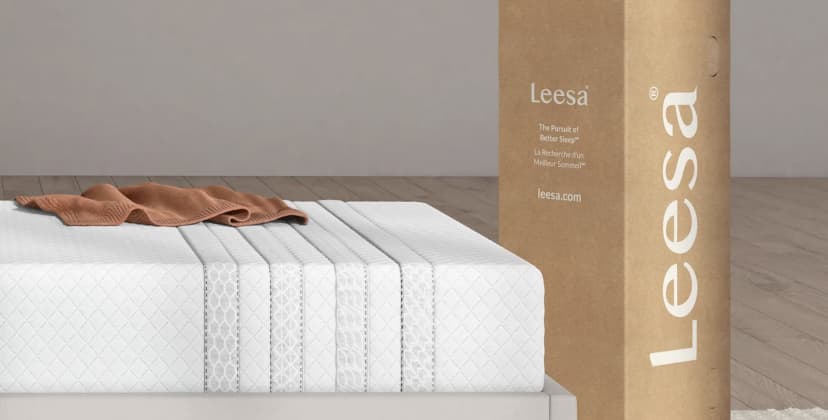
“The Leesa Sapira Hybrid checks off a lot of boxes for couples seeking a versatile mattress. It stays fairly cool and feels sturdy along the perimeter, allowing you and your partner to use the entire surface of the bed without having to worry about rolling off.” — Lauren Fountain, Senior Editor
-
Pros
-
Thick foam layers ease pressure buildup in the shoulders and hips
-
Reinforced edges boost support along the perimeter
-
Perforations in the polyfoam and airflow through coils help promote cooling
-
-
Cons
-
Side sleepers under 130 pounds may prefer a softer mattress
-
High potential for off-gassing from foam layers
-
Mattress Type
Hybrid
Firmness Options
Medium Firm (6)
Price Range
$1,349 – $2,299
Trial Period
100 nights (30 night requirement)
Product Details
The Leesa Sapira Hybrid offers a well-rounded design that should satisfy a wide swath of sleepers. The foam layers gently cradle the body without hugging too deeply, allowing the mattress to strike a nice balance between cushioning and support.
How It Performed
The Sapira Hybrid combines a thick comfort system with a sturdy coil core, earning it high ratings from side sleepers who weigh at least 130 pounds. The foam relieves pressure buildup in areas like the shoulders and hips, while the coils support the lower back to maintain healthy spinal alignment. Foam layers typically retain a lot of heat, but the polyfoam on the bed’s surface is designed with perforations that help ventilate the foam. Air circulation through the coils also helps with cooling.
What It’s Made of
The Sapira Hybrid has a medium firm (6) feel and starts with a responsive polyfoam layer, followed by a memory foam layer that conforms more closely to your body. A polyfoam transitional layer underneath acts as a buffer between your body and the coil system, ensuring your body doesn’t sink too deeply into the bed. The coils in the support core are responsive and supportive. They’re also reinforced along the perimeter to minimize sagging when you sit or sleep near the edges.
Leesa offers free shipping to all 50 states. Your mattress comes with a 100-night sleep trial and a 10-year warranty.
Best Mattress for Side Sleepers with Hip Pain
Nolah Evolution 15
35% off mattresses + 2 free pillows at Nolah
$1,624 at Nolah Sleep
“If you’re looking for a soft surface and strong stability, I highly recommend the Nolah Evolution 15 mattress. Its thick profile offers plenty of cushioning, while the coils provide the extra reinforcement needed for next-level support.” – Mark Horiuchi, Lead Product Tester
-
Pros
-
Foam comfort system relieves pressure
-
Airflow through the coil layer helps the mattress sleep cool
-
Reinforced perimeter offers substantial edge support
-
-
Cons
-
Firmer models may not contour closely enough for side sleepers
-
Thick profile may require sheets with deep pockets
-
Mattress Type
Hybrid
Firmness Options
Medium (5), Medium Firm (6), Firm (8)
Price Range
$1,004 – $2,143
Trial Period
120 nights (30-night requirement)
Product Details
The Nolah Evolution 15 is a hybrid mattress that alleviates pressure and provides sturdy support, making it particularly great if you have trouble maintaining healthy sleep posture. Multiple firmness options also make the mattress accessible to many body types. This mattress has high-quality materials and features that may be a worthwhile investment for those who primarily or occasionally use the side position.
How It Performed
The Evolution 15’s foam hybrid construction provides a supportive and cushioning surface that helps alleviate pressure. The mattress is available in three firmness levels: medium (5), medium firm (6), and firm (8). The side sleepers on our team weighing less than 230 pounds preferred the medium, while those over 230 pounds preferred the medium firm.
The mattress has significant edge support thanks to its reinforced perimeter. We were able to lie close to the perimeter and sit along the edge to tie our shoes without sinking. The zoned configuration also ensured our hips and shoulders didn’t sink too deeply into the mattress. Like other hybrids with cooling comfort layers, the Evolution 15 also offers excellent temperature control.
What It’s Made of
The comfort system is made from four polyfoam layers that each have a different purpose, starting with a quilted polyfoam Euro-top infused with Nolah’s ArcticTex, a material intended to help you stay cool. The next layer, a proprietary foam called AirFoamICE, is infused with graphite and designed to regulate temperature. The bottommost layer is resilient and provides a comfortable transition between the core and other comfort layers. The Evolution 15’s pocketed coil support core sits atop a polyfoam base. The pocketed coils have a zoned configuration, so you’ll feel more reinforcement in pressure-prone areas like your hips.
The Evolution comes in six standard sizes, as well as a split king for adjustable beds. Nolah ships the Evolution for free to shoppers who live in the contiguous U.S. The mattress is backed with an optional 120-night sleep trial and lifetime limited warranty.
Best Mattress for Side Sleepers with Shoulder Pain
Brooklyn Bedding Signature Hybrid – Soft
Save 25% sitewide at Brooklyn Bedding
$999 at Brooklyn Bedding



“The Brooklyn Bedding Signature’s foam layers cushioned and contoured to my body while the coils provided firm support. With three firmness options available, you can easily find the right level of comfort for your preferences.” – Tom Ryan, Head of Product Testing
-
Pros
-
Thick foam layers offer strong pressure relief
-
Coils generate support for the midsection
-
Air circulates through the coil system to promote cooling
-
-
Cons
-
Inadequate support for most people who weigh over 230 pounds
-
Foam layers may hug the body too tightly and trap heat
-
Mattress Type
Hybrid
Firmness Options
Medium Soft (4)
Price Range
$499 – $1,199
Trial Period
120 nights (30-night requirement)
Product Details
If you’re in the market for a mattress that offers substantial pressure relief without sacrificing support, the Brooklyn Bedding Signature Hybrid is a worthwhile option. The hybrid model comes in three firmness options, and the Signature Hybrid — Soft proved ideal for cradling areas of painful pressure buildup such as the shoulders and hips.
How It Performed
The above-average plushness of the Signature Hybrid can be beneficial if you sleep on your side or weigh less than 130 pounds. It caters to sleepers who want a mattress that contours closely to alleviate pressure while still receiving support for the midsection from the coil base.
Like many other mattresses with softer feels, the mattress excels in absorbing movement and noise. If you’re frequently disturbed by your partner’s nightly movement, we highly recommend this pick. The Signature Hybrid also earned high rankings in our temperature control tests. The coils generate steady airflow to cool off the interior, and a gel infusion in the TitanFlex foam layer absorbs and releases body heat to help the surface stay comfortable.
What It’s Made of
The Signature Hybrid — Soft begins a fabric cover quilted with polyfoam for a cushioned surface, followed by a layer of TitanFlex foam engineered to be more responsive than traditional memory foam. Next is a transition layer made from VariFlex foam that ensures even weigh distribution. The support core consists of pocketed coils over a high-density polyfoam base layer. The coils are reinforced along the perimeter, providing pushback and minimizing sinkage when you get in and out of bed.
The Signature Hybrid not only carries an affordable price-point, but also qualifies for free ground shipping anywhere in the contiguous U.S. Brooklyn Bedding offers a wide range of sizes for the mattress, including a split California king for couples who use adjustable beds and several RV-friendly options. Each order comes with a 120-night sleep trial and 10-year manufacturer’s warranty.
Best Pressure-Relieving Mattress for Side Sleepers
Layla Hybrid
$220 off + 2 free pillows at Layla. Use code: Sleepy20
$1,499 at Layla



“As a side sleeper who’s slept on the Layla Hybrid for going on 3 years, I highly recommend this mattress for the pressure relief provided by the foam layers. But the mattress really stands out for its reversible construction, which accommodates most side sleepers, whether you prefer deep cushioning or robust support.” – Tom Ryan, Head of Product Testing
-
Pros
-
Reversible design with a plush, adaptive feel on one side and a firm feel on the other
-
Reinforced perimeter coils push back against your weight to limit sinkage along the edges
-
Cover is removable and machine-washable
-
-
Cons
-
Mattress is fairly heavy and difficult to lift for flipping
-
People seeking a medium firm feel may not be satisfied with either side
-
Mattress Type
Hybrid
Firmness Options
Reversible: Medium Soft (4), Firm (7)
Price Range
$1,299 – $1,899
Trial Period
120 nights
Product Details
If you’re a side sleeper who also tends to overheat in bed, finding a comfortable mattress that offers adequate cushioning without feeling excessively warm can be challenging. The Layla Hybrid nicely balances contouring and cooling thanks to breathable foam layers and steady air circulation through the coil system. As a flippable mattress with medium soft (4) and firm (7) surfaces, the hybrid also accommodates most side sleepers regardless of how much they weigh.
How It Performed
During our hands-on tests, we evaluated both sides of the Layla Hybrid. Side sleepers on our team weighing less than 130 pounds preferred the softer side for its close contouring and cushioning around the shoulders and hips. Those weighing more than 230 pounds received sufficient support on the firm side. For those between 130 and 230 pounds, both sides felt comfortable. Our back and stomach sleepers largely preferred the firm side.
We noticed that each surface performed well in areas where the opposite side fell short. Pressure relief and motion isolation were major strengths of the medium soft side, while the firm side earned higher ratings for edge support and ease of movement. Temperature control was one area where both sides excelled. We detected little to no heat buildup on either surface.
What It’s Made of
The Layla Hybrid’s softer side begins with 2.5 inches of memory foam, followed by a 2-inch transitional polyfoam layer. This surface contours deeply to cradle your body and alleviate pressure along the spine, but the transitional layer is zoned to prevent uncomfortable sinkage beneath your midsection. The firmer side includes the same materials, but the layers are thinner to create a more supportive feel with moderate conforming. Copper infusions in the memory foam layers are intended to offset heat absorption and help you stay cool.
Pocketed coils between the foam layers provide support and stability to both sides of the mattress. Extra reinforcement along the perimeter prevents you from sinking too much when lying near the edges or getting in and out of bed. At 104 pounds in a queen size, the Layla Hybrid is fairly hefty and may require two or more people to lift and flip when you want to change the firmness. Robust carrying handles on each side aid with this process. A stretchy polyester, rayon, viscose, and poly-lycra cover encases the mattress. You can remove and machine wash this cover to keep your sleep surface hygienic.
The Layla Hybrid is competitively priced, and standard ground shipping is free for orders in the contiguous U.S. Layla’s sleep trial runs for 120 nights. If you choose to keep the mattress, you’ll also receive a manufacturer’s warranty covering structural defects for up to 10 years.
Best Spinal Alignment Mattress for Side Sleepers
Bear Elite Hybrid
35% off + 2 free pillows at Bear. Code: SF36
$1,499 at Bear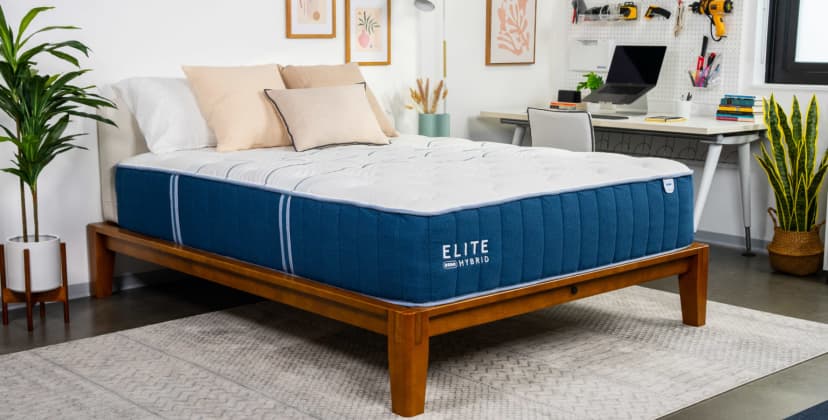
“The thick foam layers of the Bear Elite Hybrid provide just the right amount of cushioning without sacrificing support, making it one of the most comfortable mattresses I’ve tried. If you’re like me and appreciate gentle contouring, I highly recommend giving this mattress a try.” – Lauren Fountain, Senior Editor
-
Pros
-
Foam comfort system offers ample pressure relief
-
Supportive coils prevent excessive sinkage
-
Cover is composed of cooling fabrics
-
-
Cons
-
Coils can generate motion transfer that disrupts sleep for couples
-
14-inch profile may require new sheets with deep pockets
-
Mattress Type
Hybrid
Firmness Options
Medium (5), Medium Firm (6), Firm (8)
Price Range
$1,231 – $2,548
Trial Period
120 nights (30-night break-in period)
Product Details
The Bear Elite Hybrid is a well-balanced mattress that combines foam’s cushioning with the strong support of pocketed coils. The mixed-foam comfort system relieves pressure, making this an ideal model if you frequently wake up with aches and pains.
How It Performed
The mattress comes in three firmness options that appeal to different sleepers, depending on your body type and sleep preference. The medium (5) has the plushest feel and appeals to side and back sleepers up to 130 pounds. The medium firm (6) strikes an even balance of cushioning and support that is most beneficial to side and back sleepers up to 230 pounds. The firm (8) model is best suited for back and stomach sleepers over 130 pounds.
Hot sleepers on our team found this bed very comfortable, thanks to the strong ventilation through the coils. The cover is also engineered to wick away moisture and maintain a neutral surface temperature. As a result, our heat guns detected minimal heat retention on the surface. We also recommend the mattress to couples who prioritize responsiveness for sex. The coils create a bouncy feel that was easy for our testers to move across.
What It’s Made of
The mattress begins with a quilted cover and a memory foam layer that adapts closely to your body. Beneath is a layer of polyfoam that further promotes contouring but has a firmer feel to prevent the body from sinking into the support core. The core is composed of zoned pocketed coils that offer strong support but also respond to the body for gentle pressure relief. The cover is made from a Celliant-blend fabric infused with phase change material designed to keep the surface cool.
Bear offers a 120-night sleep trial for customers to try out the mattress, during which you can return it anytime after a 30-night break-in period. A lifetime warranty protects the Bear Elite Hybrid against structural defects. Shipping is free to the contiguous U.S.
Best Temperature Regulating Mattress for Side Sleepers
Birch Mattress
20% off + 2 free pillows at Birch
$1,499 at Birch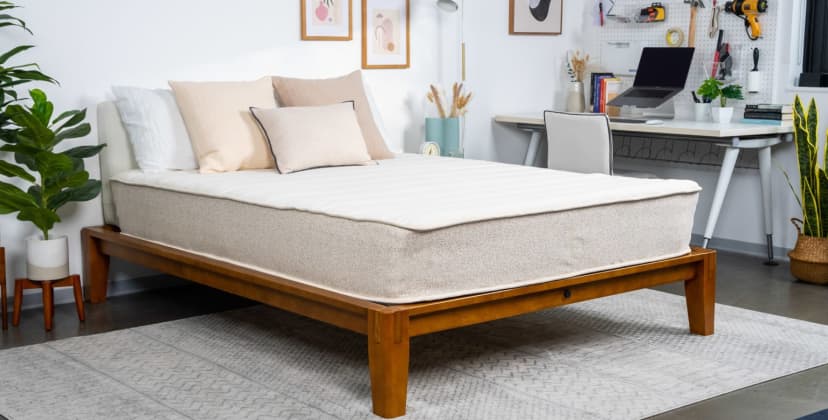
“I like that the Birch Mattress doesn’t have the classic ‘hugging’ feel of memory foam, but still offers gentle contouring, strong edge support, and exceptional bounce. It’s also eco-friendly, which is a big plus.” – Jeremy Klein, Senior Product Expert
-
Pros
-
Made with eco-friendly materials
-
Sleeps exceptionally cool
-
Long expected lifespan
-
-
Cons
-
Minimal contouring can lead to pressure buildup for people under 130 pounds
-
Responsive latex layer may cause sleep disturbances for couples
-
Mattress Type
Latex Hybrid
Firmness Options
Medium Firm (6)
Price Range
$1,099 – $1,799
Trial Period
100 nights (30-night requirement)
Product Details
The Birch Mattress is a latex hybrid featuring an assortment of natural and organic components. These materials make the mattress a good option for side sleepers seeking a supportive, pressure-relieving mattress that’s also sustainably produced.
How It Performed
The mattress is medium firm (6). Its highly responsive feel comes from a latex comfort layer that conforms gently, and the pocketed coil support core. The bouncy surface allowed us to get in and out of bed, change positions, and crawl across the mattress with ease. A reinforced perimeter enables you to utilize the entire surface of the bed. This zoning held up well in our testing lab, as we could easily tie our shoes while sitting on the Birch Mattress’ edges and experienced plenty of pushback lying along the perimeter.
The robust support core provided ample support for our side sleepers weighing 130 pounds or more, while the latex offered enough contouring to relieve pressure points. Our lighter testers experienced more of a floating sensation, and the bed felt a bit firmer for them. Depending on their personal preferences, side sleepers weighing less than 130 pounds may want to look for a model with more cushioning for the shoulders and hips.
What It’s Made of
The Birch Mattress’ comfort system begins with a blend of organic wool and rayon that cushions the surface and encourages airflow. Underneath is a second layer of wool that acts as a natural fire barrier, followed by Talalay latex. The latex gently cradles your body to reduce pressure buildup while providing enough responsiveness to keep you on an even plane. A pocketed coil system makes up the support core, offering targeted support to the hips and shoulders and reinforcing the perimeter of the mattress. The coils rest on a base layer of wool and rayon for stability, and a breathable organic cotton cover encases the mattress.
Birch offers free shipping to customers within the contiguous U.S. The mattress comes with a 100-night sleep trial to test the mattress. If you decide to keep the mattress, it comes with a 25-year warranty against structural defects.
Video: We Tested 2024’s Best Mattresses for Side Sleepers — Here Are Our Favorites
How We Test: Rigor, Data, and Sleeper Feedback
To choose the best mattresses for side sleepers, our testing team (of primarily side and combination sleepers) looked first and foremost for beds that offered strong pressure relief in the shoulders and hips. We also assessed ideal firmness levels for side sleepers of different body weights, as well as ease of movement and edge support — all important factors for this sleeping position. Finally, we incorporated subjective feedback from real customers who have owned these beds and loved them.

At Sleep Foundation, we’ve personally tested nearly 2,000 mattresses over the past eight years in our Seattle-based Test Lab.
Our product testing team obsesses over the science of sleep and the latest in sleep trends, and many of us have spent time working directly with manufacturers. Since a bed’s comfort and feel largely depends on your body weight and sleeping position, the testers on our team represent a wide range of body types, sleep positions, and comfort preferences.
To get to our selections for top picks, we evaluate mattresses across a number of performance and testing categories. Specifically, we look at construction analysis and pour over product research in our database. We conduct quantitative testing in our Seattle-based Test Lab, perform field testing in our homes, and perhaps most importantly, solicit feedback from owners to see how the bed sleeps in the real world.
To learn more about our mattress evaluation process, you can check out our research methodology page, but below is a quick breakdown.
Construction analysis: Our ratings system is grounded in construction. Each mattress rating is derived at the intersection of quality, value, and versatility across a range of sleepers. We look at the bed’s price point, materials, firmness options, comfort and support systems, cooling technology, as well as brand reputation, and then we perform a detailed analysis that measures performance across six different categories to arrive at an overall score.
Quantitative product testing: During these hands-on lab tests, our team uses various tools and technology to evaluate a bed’s performance against motion isolation, pressure relief, temperature control, ease of movement, edge support, and potential for odor emissions. We use the outcomes of these tests to calculate a score for each category.
Field testing: Our field testers sleep on mattresses and other sleep products, like pillows, sheets, and mattress toppers, in their own bedrooms. After weeks of at-home testing, each field tester provides a detailed analysis of how the mattress performs, including what they like and dislike about the bed.
User feedback: Observations from mattress owners and users outside our team are invaluable to our research. We draw insight from surveys, sleep stories, and customer reviews to extract themes, fine-tune our ratings, and better understand how each product performs over time in a real-world setting.
motion isolation
This criteria alludes to the amount of motion a mattress absorbs when a sleeper moves on the surface. We use two testers lying side by side to evaluate motion isolation, who each feel for transfer while the other person moves on the mattress.
temperature control
To determine how well a mattress regulates temperature, we perform temperature tests and look closely at its materials and construction. Many mattresses are designed with cooling components meant to reduce heat retention.
pressure relief
A bed with strong pressure relief excels at preventing pressure from building up in areas like the shoulders and hips. Beds with even contouring and weight distribution are top performers when it comes to pressure relief.
Off-Gassing
A mattress in a box may release unpleasant chemical odors for a short period after you’ve unboxed it. The initial smell may be strong but typically fades within 2 or 3 days.
ease of movement
This criteria reflects how easily a sleeper can move across a bed’s surface. Responsive surfaces made of latex typically perform better than foam surfaces, which can inhibit movement.
edge support
We perform sit tests along a bed’s perimeter to measure how well the edges push back against weight. Mattresses with strong edge support have minimal sagging when sleepers sit on or lie close to the perimeter.
What to Look for in a Mattress for Side Sleepers
If you’re a side sleeper, your sleeping position should factor into your decision when choosing a new mattress. Understanding how different mattress attributes affect your overall comfort is key to finding the right mattress for you.
What Do You Need From Your Bed?
The ideal mattress for side sleepers should provide enough cushioning to alleviate pressure along your spine while maintaining an even surface for your entire body. If a mattress feels too soft, you’re more likely to sink in compromising your alignment. Too firm a mattress can lead to pressure buildup in the shoulders and hips.
Contouring and Pressure Relief
Contouring refers to how well the mattress conforms to your body. A mattress that conforms closely and evenly can produce a cloud-like cradling effect that alleviates pain and pressure points. This is particularly beneficial for people with arthritis, joint pain, and other health conditions that impact sleep.
A mattress that contours too closely, however, may sink too much — especially if you weigh more than 230 pounds. This is why a happy medium is key. Most side sleepers prefer mattresses that contour, but without hugging their body too tightly.
Firmness and Spinal Alignment
If your spine is not evenly aligned, pressure can build up in areas like the shoulders and hips because these sink more deeply into the mattress. Side sleepers should look for mattresses that feel supportive enough to prevent the shoulders and hips from sinking, but soft enough to still reduce pressure in these areas.
In terms of our 10-point firmness scale, side sleepers below 130 pounds can get the cushioning and support they need from soft (3) or medium soft (4) mattresses. Heavier sleepers need extra support to minimize sinkage, so a medium (5), medium firm (6), or firm (7) mattress is usually best for higher weights.
Mattress Material
Many side sleepers enjoy the deep contouring of memory foam or adaptive polyfoam. Both materials mold closely and respond slowly to movement, creating a fluffy surface to reduce pain and pressure points. Others prefer latex, which gently conforms to the body, responds quickly, and gives a light bounce when you move on it.
Core support materials also play a big role in how your mattress feels. An all-foam mattress with a dense polyfoam base layer provides cushioning across the whole mattress. Latex mattresses have denser support layers to reinforce the bouncy surface feel. Innersprings and hybrids tend to be the sturdiest because their support cores contain thick steel coils.
Temperature Regulation
If you’re a side sleeper who runs hot, an all-foam mattress may not be ideal. Foam layers are great at cushioning and relieving pressure, but they also tend to trap heat. A latex , hybrid, or innerspring mattress may be a better alternative because they are better at promoting airflow and minimizing heat retention.
Mattress Shopping Tips for Side Sleepers
Buying a new mattress can be a big decision. Here are some tips to help you navigate the experience – tailormade for side sleepers like you.
Is Your Mattress No Longer Serving You?
Every mattress wears out and needs to be replaced eventually. But how can you tell when it’s your bed’s turn to clock out? These signals manifest in different ways, but common signs include the following.
- You wake up achy and sore: Impressions that form on your mattress over time can make the surface feel uneven, leading to added pain and pressure. Side sleepers are especially prone to achiness and soreness in their shoulders and hips.
- You consistently feel tired: An uncomfortable mattress can negatively impact your sleep quality and duration. If you frequently wake up feeling tired, your mattress may be partially to blame..
- You can see or hear damage: Indentations of 1 inch or deeper, permanent sagging along the perimeter, and disruptively creaky springs all indicate your mattress is nearing the end of its lifespan.
- Your mattress has aged out: The average mattress performs for seven years before a replacement is needed. You’ll probably see signs of light wear and tear after five years of use.
Prepare Your Budget
Most mattresses sold today cost between $1,000 and $2,000 for a queen size. All-foam and innerspring models typically carry the lowest price-points, while hybrids, all-latex models, and airbeds are more expensive. Other factors include mattress size and whether you buy directly from a brand or at a retail store. Shipping and returns may also influence cost, so be sure to check for hidden fees when reviewing the brand’s policies.
Choose Your Shopping Method
The recent influx of direct to consumer mattress companies means you can purchase a new bed from the comfort of your own…bed, but many people prefer visiting a store to see how the bed feels before they buy it. Both options have merits, listed in the chart below.
Most online mattress brands will let you test the mattress in your own home. Most sleep trials last at least 90 nights, and you can usually return the bed without extra charges if you’re not satisfied. Standard manufacturer’s warranties last at least 10 years, but always check with the company regarding their policy.
| Shopping Online | Shopping In Stores | |
| Pros | ||
| Cons |
Dive Deeper — Mattress Guides By Category
For more information on how we choose the best mattresses for different types of sleepers, check out the guides listed below.
Shopping Guides by Mattress for Sleeper Types
Frequently Asked Questions
Side sleepers should choose mattresses that provide a balance of sturdy support and cushioning for the shoulders and hips. Our tests show foam, latex, and hybrid mattresses that fall between medium soft and medium firm are most comfortable for side sleeping, depending on your body type.
Mattresses that feel too firm and don’t cushion the body closely enough can create painful pressure buildup for side sleepers. The same is true of mattresses with thin padding. If a mattress feels too soft, your shoulders and hips may sink too deeply, leading to added soreness.
If you’re a side sleeper weighing less than 130 pounds, a soft (3) to medium soft (4) should provide plenty of cushioning for your shoulders and hips without sinking too much. Side sleepers between 130 and 230 pounds usually prefer medium (5) to medium firm (6) mattresses for the same reason, while those over 230 pounds often need a firm (7) mattress to keep their body on an even plane.
Side sleepers with shoulder pain should consider a zoned mattress that feels softer and more adaptive beneath the shoulders, and firmer under the stomach and hips. This helps ensure adequate pain and pressure relief without sacrificing support for the midsection.
All-foam or hybrid mattresses with thick, adaptive comfort layers are generally recommended for side sleepers with back pain. These models contour closely to alleviate achiness and soreness in the lumbar region and hips, but many are equipped with sturdy support cores to prevent uncomfortable sinkage.
Foam layers cushion and cradle the body, making foam mattresses a good match for many side sleepers. Memory foam offers closest and most even contouring to help distribute weight, promote proper alignment, and reduce pressure along the spine. If you’re a hot sleeper, we recommend open-cell foam designed to resist heat buildup.

Still have questions?
Our product experts have extensive experience testing just about every sleep product on the market.
Send an email to [email protected] with your questions and we’ll help you find exactly what you’re looking for.





